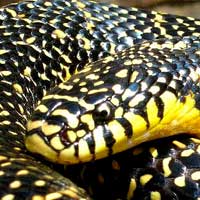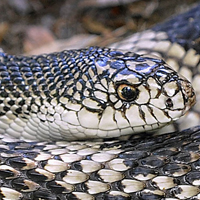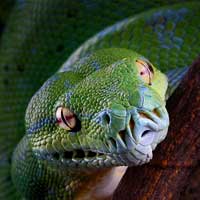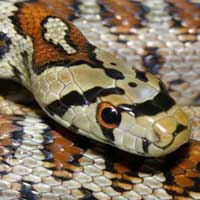Madagascar Tree Boa: A Stunning Arboreal Wonder
The Madagascar Tree Boa is scientifically named Sanzinia madagascariensis. It belongs to the Boidae family, which includes non-venomous constrictor snakes.
Scientific Name: Sanzinia madagascariensis
Snake Family: Boidae

Madagascar Tree Boa: An Overview
The Madagascar Tree Boa (Sanzinia madagascariensis) is a captivating, non-venomous snake species native to the island of Madagascar. Renowned for its vibrant patterns and arboreal lifestyle, this boa is a favorite among reptile enthusiasts. Its manageable size and striking appearance make it an excellent choice for advanced keepers. This guide will explore everything from habitat and diet to care and reproduction of this fascinating species.
Where Does the Madagascar Tree Boa Live?
The Madagascar Tree Boa thrives in the tropical and subtropical forests of Madagascar. As an arboreal species, it prefers environments with dense vegetation and plenty of branches for climbing.
| Habitat Feature | Description |
|---|---|
| Geographic Range | Madagascar, particularly in the eastern rainforests |
| Preferred Environment | Tropical forests, near water sources |
| Climate | Warm and humid, with temperatures ranging from 75-85°F |
Understanding the Diet of the Madagascar Tree Boa
The Madagascar Tree Boa is a carnivore, primarily feeding on small mammals, birds, and reptiles in the wild. In captivity, its diet should replicate natural feeding habits as closely as possible.
- Juveniles: Feed on pinky mice or small lizards every 5-7 days.
- Adults: Feed on medium-sized rodents or birds every 10-14 days.
- Prey Size: Ensure the prey is no larger than the snake’s widest part.
- Hydration: Provide a water dish large enough for soaking.
Behavior and Temperament of the Madagascar Tree Boa
The Madagascar Tree Boa exhibits intriguing behavior, including its arboreal tendencies and nocturnal activity patterns. While generally docile, individual temperament can vary.
- Arboreal Lifestyle: Spends much of its time coiled on branches.
- Nocturnal Activity: Most active during the night, using heat-sensing pits to locate prey.
- Docile Nature: Can become accustomed to handling with regular interaction.
- Defensive Behavior: May hiss or coil if it feels threatened.
Ensuring the Health and Longevity of the Madagascar Tree Boa
With proper care, the Madagascar Tree Boa can live 15-20 years in captivity. Regular health monitoring and maintaining an appropriate habitat are essential for its well-being.
| Health Issue | Symptoms | Prevention |
|---|---|---|
| Respiratory Infection | Wheezing, open-mouth breathing | Maintain proper humidity and temperature |
| Skin Issues | Discoloration, incomplete shedding | Provide a humid environment and clean enclosure |
| Parasites | Visible mites, itching | Regularly clean the enclosure |
Reproduction in the Madagascar Tree Boa
Madagascar Tree Boas are ovoviviparous, meaning they give birth to live young. Breeding in captivity can be challenging but rewarding for experienced keepers.
- Mating Season: Late winter to early spring.
- Gestation Period: Approximately 6-7 months.
- Litter Size: Typically 6-12 young.
- Provide a temperature drop during the mating season to encourage breeding behavior.
Tips for Handling and Caring for the Madagascar Tree Boa
Handling and caring for a Madagascar Tree Boa requires patience and consistency. Proper setup and regular interaction can ensure a stress-free experience for both keeper and snake.
- Provide an enclosure with vertical space, including branches for climbing.
- Maintain a temperature gradient of 75-85°F and humidity levels between 60-80%.
- Handle gently and infrequently to avoid stress.
- Offer a diet appropriate for the snake’s size and age.
- Clean the enclosure regularly to prevent health issues.







